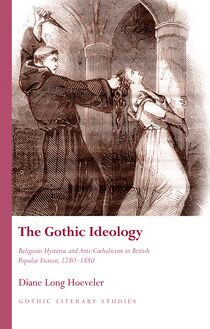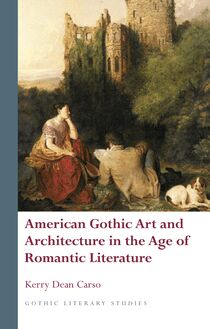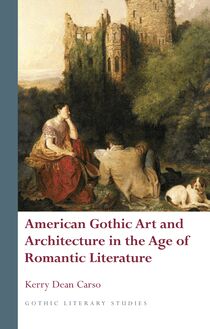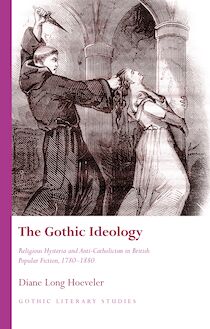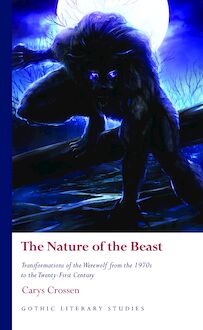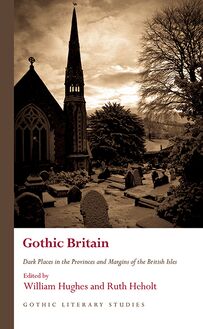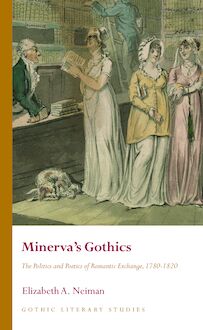-
 Univers
Univers
-
 Ebooks
Ebooks
-
 Livres audio
Livres audio
-
 Presse
Presse
-
 Podcasts
Podcasts
-
 BD
BD
-
 Documents
Documents
-
- Cours
- Révisions
- Ressources pédagogiques
- Sciences de l’éducation
- Manuels scolaires
- Langues
- Travaux de classe
- Annales de BEP
- Etudes supérieures
- Maternelle et primaire
- Fiches de lecture
- Orientation scolaire
- Méthodologie
- Corrigés de devoir
- Annales d’examens et concours
- Annales du bac
- Annales du brevet
- Rapports de stage
La lecture à portée de main
Vous pourrez modifier la taille du texte de cet ouvrage
Découvre YouScribe en t'inscrivant gratuitement
Je m'inscrisDécouvre YouScribe en t'inscrivant gratuitement
Je m'inscrisEn savoir plus
Vous pourrez modifier la taille du texte de cet ouvrage
En savoir plus

Description
Prior studies of post-war American Gothic literature (and even American horror films) have primarily interpreted Gothic cultural production of the post-war period through a Cold War lens. Despite legitimate reasons for such an approach, this emphasis has limited inquiries into post-war fiction as well as our understanding of the nation’s complicated identity. While the federal government and its investigative agencies may have been preoccupied with the so-called ‘red menace’ that threatened to spread across the planet, each region of the country already possessed major strains of Gothic fiction that focused on regional anxieties – namely of those connected to women and minorities that threatened the region’s constructed identity and balance of power. The Haunted States of America shifts the focus to these Gothic strains by examining how the anxieties, fears and concerns illustrated in the works of several post-World War II writers can be best understood through regional history and identity.
Acknowledgements
Introduction
1 ‘The Death of a Culture’: Subversion of Monstrosity in the Southern Gothic
2 Hanging Women on the Hill: Exposure of Patriarchal Conformity in the
New England Gothic
3 Haunted Grounds of Healing: Horrors of Normativity and Genocide in
the Gothic Midwest
4 New York, New York…: Greed and Abjection in the New York Gothic
5 Repressed Ramonas and Braceros: Return of the Oppressed in the
Southern California Gothic
Coda
Works Cited
Sujets
Informations
| Publié par | University of Wales Press |
| Date de parution | 15 mai 2022 |
| Nombre de lectures | 0 |
| EAN13 | 9781786838780 |
| Langue | English |
Informations légales : prix de location à la page 0,4400€. Cette information est donnée uniquement à titre indicatif conformément à la législation en vigueur.
Extrait
THE HAUNTED STATES OF AMERICA
SERIES PREFACE
Gothic Literary Studies is dedicated to publishing groundbreaking scholarship on Gothic in literature and film. The Gothic, which has been subjected to a variety of critical and theoretical approaches, is a form which plays an important role in our understanding of literary, intellectual and cultural histories. The series seeks to promote challenging and innovative approaches to Gothic which question any aspect of the Gothic tradition or perceived critical orthodoxy. Volumes in the series explore how issues such as gender, religion, nation and sexuality have shaped our view of the Gothic tradition. Both academically rigorous and informed by the latest developments in critical theory, the series provides an important focus for scholarly developments in Gothic studies, literary studies, cultural studies and critical theory. The series will be of interest to students of all levels and to scholars and teachers of the Gothic and literary and cultural histories.
SERIES EDITORS
Andrew Smith, University of Sheffield
Benjamin F. Fisher, University of Mississippi
EDITORIAL BOARD
Kent Ljungquist, Worcester Polytechnic Institute Massachusetts
Richard Fusco, St Joseph’s University, Philadelphia
David Punter, University of Bristol
Chris Baldick, University of London
Angela Wright, University of Sheffield
Jerrold E. Hogle, University of Arizona
For all titles in the Gothic Literary Studies series visit www.uwp.co.uk
The Haunted States of America
Gothic Regionalism in Post-war American Fiction
James Morgart
© James Morgart, 2022
All rights reserved. No part of this book may be reproduced in any material form (including photocopying or storing it in any medium by electronic means and whether or not transiently or incidentally to some other use of this publication) without the written permission of the copyright owner. Applications for the copyright owner’s written permission to reproduce any part of this publication should be addressed to the University of Wales Press, University Registry, King Edward VII Avenue, Cardiff CF10 3NS.
www.uwp.co.uk
British Library Cataloguing-in-Publication Data
A catalogue record for this book is available from the British Library.
ISBN 978-1-78683-876-6
e-ISBN 978-1-78683-878-0
The right of James Morgart to be identified as author of this work has been asserted in accordance with sections 77 and 79 of the Copyright, Designs and Patents Act 1988.
The publisher has no responsibility for the persistence or accuracy of URLs for any external or third-party internet websites referred to in this book, and does not guarantee that any content on such websites is, or will remain, accurate or appropriate.
For Kathrin
C ONTENTS
Acknowledgements
Introduction
1 ‘The Death of a Culture’: Subversion of Monstrosity in the Southern Gothic
2 Hanging Women on the Hill: Exposure of Patriarchal Conformity in the New England Gothic
3 Haunted Grounds of Healing: Horrors of Normativity and Genocide in the Gothic Midwest
4 New York, New York … : Greed and Abjection in the New York Gothic
5 Repressed Ramonas and Braceros: Return of the Oppressed in the Southern California Gothic
Coda
Notes
Works Cited
A CKNOWLEDGEMENTS
I am indebted to Sanford Schwartz, Michael Bérubé, Jonathan Eburne, Mark Morrisson and Dale Townshend for their support of this project from its inception and for their continued professional support and friendship. I sincerely thank the librarians at Mary F. Shipper Library for tracking down invaluable information, especially Virginia Stephens and Nicholas Gardner. I must also thank Sarah Lewis and University of Wales Press for taking a chance on my first attempt at a book-length literary study.
As I have worked on this book, I have had the distinct privilege of both learning from and working beside the brilliant faculty at Rider University, The Pennsylvania State University, New Jersey City University, Rutgers University and Potomac State College. I remain inspired by these professors’ unwavering dedication to their fields and to their students. Without encountering them, I would have never written and completed this book.
I also extend a very warm thanks to all my friends and family whose support while pursuing this project helped me to maintain my sanity and focus. Adam Torkel, Martin Sanelli, Debbie Rochon, Susan Heckel, Keryn Thompson, Damon Cagnolatti and Allison Morgart have all over the past nine years supported and encouraged me. Most particularly, Vic Fraternale’s unwavering friendship has made every valley not so low nor so lonely. I am also deeply grateful for Roberta Clipper’s mentorship. Without her support, scholarship would have remained something alien to me, a strange academic production hidden away in obscure databases and on dust-covered bookshelves. I especially owe all my successes to my parents, Rose and Jim, whose support have been second to none. My mother’s voracious appetite for books and my father’s mantra of ‘question everything’ indubitably led me here.
Above all else, I owe this book to Kathrin, Ada and Henry. Completing this project required sacrifices, and it takes a special type of family to endure the thousand cuts that those sacrifices can make. Without Kathrin’s support, this study would be stored on a hard drive incomplete. Without Kathrin, Ada and Henry’s love, I would be equally incomplete. Du bist meine Welt. Thank you.
Finally, no work of scholarship would be complete without permission from authors, their estates and/or their publishers, and I am appreciative of everyone who assisted me in the process of securing permissions. Excerpts from Intruder in the Dust by William Faulkner, copyright 1948 by Penguin Random House LLC. Copyright renewed 1975 by Jill Faulkner Summers. Used by permission of Random House, an imprint and division of Penguin Random House LLC. All rights reserved. Excerpts from Lie Down in Darkness by William Styron, copyright © 1951, copyright renewed 1979 by William Styron. Used by permission of Random House, an imprint and division of Penguin Random House LLC. All rights reserved. Excerpts from Hangsaman by Shirley Jackson, copyright 1951 by Shirley Jackson. Used by permission of Penguin Books, an imprint of Penguin Publishing Group, a division of Penguin Random House LLC. All rights reserved. Excerpts from The Martian Chronicles reprinted by permission of Don Congdon Associates, Inc. © 1950, renewed 1977 by Ray Bradbury. Excerpts from The Barbarous Coast by Ross Macdonald, copyright © 1956 by Ross Macdonald. Used by permission of Alfred A. Knopf, an imprint of the Knopf Doubleday Publishing Group, a division of Penguin Random House LLC, and by permission of Harold Ober Associates. All rights reserved.
Introduction
Central to this study on Gothic regionalism and post-war American fiction is the Gothic’s relationship to ‘outsiders’ that ‘insiders’ treat as abnormal and subsequently exclude or eject from their culture. The very word ‘Gothic’ derives from Visigoths and Ostrogoths – Germanic tribes living on the outskirts of an ‘advanced’ Roman empire that depicted these groups as ‘uncivilised’. 1 This association of ‘Gothic’ with people known for their ‘wild’ or ‘barbaric’ culture and behaviour led to Renaissance critics coining the phrase ‘Gothic architecture’ to describe ‘gloomy’ architectural designs and ‘sombre castles [that] appeared dark and barbarous’. 2 Reminiscent of how the ostracised Goths evoked feelings of disgust and horror from the Romans, medieval architecture reminded neoclassical critics of an unsophisticated, barbaric past. As Montague Summers observes, until the eighteenth century, ‘the word “Gothic” … conveyed the idea of barbarous, tramontane, and antique, and was merely a term of reproach and contempt … [and] came to connote almost anything medieval’. 3 Fittingly perhaps, Gothic literature has been most readily identified by what Fred Botting categorises as ‘negative aesthetics’. 4 As Valerie Steele and Jennifer Park assert, set in opposition to and as an outcast from neoclassical norms, early Gothic literature ‘was characterized by gloomy settings (such as ruined castles), mysterious, violent, and supernatural events, and a general atmosphere of degeneration and decay’. 5 These texts countered Enlightenment norms, revelling in the darkness and insecurity of the unknown and providing spine-tingling thrills and imaginative, often terrifying, fantasies. In other words, from its very inception, Gothic literature featured aberrant aesthetics, behaviours and ideas.
Although the Gothic shifted in its signification – from a group of loathed barbarians to a detested medieval architecture to a popular yet debased literature centred on entertaining readers – all of these uses are indicative of Otherness that offended, terrified or disgusted those responsible for representing (or even constructing) ‘normality’. Rather unsurprisingly, despite Gothic literature’s popularity following the publication of what is widely recognised as the first Gothic novel, Horace Walpole’s The Castle of Otranto (1764), the Gothic genre held a fairly dubious position among contemporary literary and social critics. 6 As Devendra P. Varma details, initial critical responses to the Gothic were that it featured subject matter ‘not worthy of attention’ and ‘suited to gratify only a vitiated and uncultivated taste’. 7 Over time, the Gothic came to be associated with ‘wild or ghastly imagination’, thereby removing some of its ‘stigma of inferiority’. 8 However, as Anne Williams shows, a number of prominent critics ranging from F. R. Leavis to Wayne Booth were far from willing to accept that the Gothic had shed its ‘stigma’. As Williams puts it, ‘twentieth-century keepers of the House of Fiction have always treated Gothic as a skeleton in the closet’. 9 This Otherness is at the heart of the Gothic, and it is why subsequent scholars have repeatedly observed it
-
 Univers
Univers
-
 Ebooks
Ebooks
-
 Livres audio
Livres audio
-
 Presse
Presse
-
 Podcasts
Podcasts
-
 BD
BD
-
 Documents
Documents
-
Jeunesse
-
Littérature
-
Ressources professionnelles
-
Santé et bien-être
-
Savoirs
-
Education
-
Loisirs et hobbies
-
Art, musique et cinéma
-
Actualité et débat de société
-
Jeunesse
-
Littérature
-
Ressources professionnelles
-
Santé et bien-être
-
Savoirs
-
Education
-
Loisirs et hobbies
-
Art, musique et cinéma
-
Actualité et débat de société
-
Actualités
-
Lifestyle
-
Presse jeunesse
-
Presse professionnelle
-
Pratique
-
Presse sportive
-
Presse internationale
-
Culture & Médias
-
Action et Aventures
-
Science-fiction et Fantasy
-
Société
-
Jeunesse
-
Littérature
-
Ressources professionnelles
-
Santé et bien-être
-
Savoirs
-
Education
-
Loisirs et hobbies
-
Art, musique et cinéma
-
Actualité et débat de société
- Cours
- Révisions
- Ressources pédagogiques
- Sciences de l’éducation
- Manuels scolaires
- Langues
- Travaux de classe
- Annales de BEP
- Etudes supérieures
- Maternelle et primaire
- Fiches de lecture
- Orientation scolaire
- Méthodologie
- Corrigés de devoir
- Annales d’examens et concours
- Annales du bac
- Annales du brevet
- Rapports de stage


